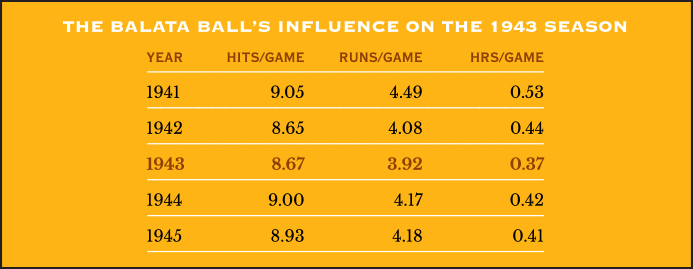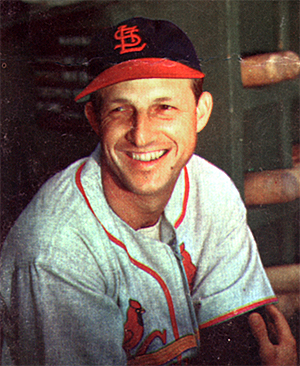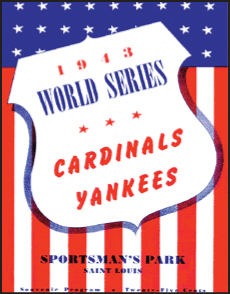THE YEARLY READER
1943: War and Games
Baseball obliges to the war effort with a late start, an inferior ball and a series of all-star fundraisers, while it’s becoming painfully obvious to fans that the level of quality isn’t what it was a few years earlier.

While star players such as Joe DiMaggio (far left) swapped a New York Yankees jersey for an army uniform as World War II intensified, benchwarmers like Guy Curtright (right) were able to briefly excel within a diluted major league talent pool. (The Rucker Archive)
Bear Mountain was a beautiful place to head for winter sports in southern New York, even as the calendar drew closer to spring. Trees were still sticks without leaves, clanking about in the cold northern winds. Snow was everywhere. Only the ski conditions were ripe.
It was the last place anyone would think of for a baseball team to hold spring training. But there they were, the Brooklyn Dodgers, camped out at Bear Mountain—a forced substitute for their usual spring training digs in Florida—before the start of the 1943 season.
Over the winter, the news from abroad was not encouraging, with the Allies enduring their darkest hours of World War II. The Axis powers controlled much of Europe, extending into the Soviet Union and North Africa; in the Pacific, Japanese expansion had practically bordered across from the Hawaiian Islands down to Australia.
Digging in for the long haul, Americans at home began to devote more time and energy to the war effort; travel, essential materials and electricity were all but rationed. Big league baseball, virtually untouched by deep sacrifice through the 1942 season, was about to be hit hard for 1943.
The first signs that all would be far from normal for the coming season occurred when commissioner Kenesaw Mountain Landis convinced owners to abandon their normal spring campsites out west or in Florida and stay close to home, arguing that long distance transportation was best left available to those directly involved in the war effort. Since all 16 major league teams occupied the Northeast portion of the country, their temporary spring outposts would resemble anything but the warm edens of paradise normally occupied by ballplayers in March.
The scramble to find suitable, nearby facilities became pot luck. With late winter conditions forcing them indoors, teams practiced in structures that ranged from aircraft hangars to horse stables to their own hotel rooms. If the weather behaved outside, baseball fields were suspect at best, and sometimes a fairway on a golf course would have to make do.
Travel restrictions also kept teams from playing exhibitions against each other, lest they were close by. They often found themselves squaring off against local military or semipro squads—if they could first defrost the field.
BTW: Exhibition games north of the Mason-Dixon Line in March would be an especially numbing experience for a healthy contingent of Cubans recruited by the Washington Senators, who hired the players in hopes they would not be exposed to the military draft.
There would be few perks once the regular season began, starting a week later than normal and including an abundance of doubleheaders—all to conserve on energy usage. Before the year was over, the Chicago White Sox would set the pace by participating in a record 44 twinbills.
Some 200 major leaguers were inducted into the military, four times as many as the year before. Minor leaguers who had no business being in the majors were there anyway, while common players who had no business being All-Stars were nonetheless becoming them. For many, the thrills would be a short-lived experience. To wit: Guy Curtright, a rookie for the Chicago White Sox, hit in 26 straight games to establish an American League rookie record and finished fifth in the league with a .291 batting average. By the time baseball returned to full strength in 1946, Curtright—who ideally should have been in his prime—would be reduced to a bench player and, a year later, be completely gone from the game.
The majors’ gain in filling up the rosters continued to be the minor leagues’ loss. Crippled by a shortage of talent, only nine minor leagues finished the season in 1943—down from 26 the year before. Major league farm systems were also vanishing; the St. Louis Cardinals’ prodigious minor league network shriveled to a mere six teams, while the White Sox wouldn’t have a single minor league affiliation for three straight years starting in 1943.
Then there was the disaster known as the balata ball.
With rubber scarce, the majors introduced a new ball made up of “non-essential” elements—a combination of low-grade cork, low-grade horsehide and, in the place of rubber, a substance called balata—produced from the milk of tropical trees. A.G. Spalding, the official ball manufacturer, proclaimed that this new ball would be as juicy as those used before the war.
If correct, Spalding would have had a hard time explaining it after the season’s first week—which produced 11 shutouts and a collective .223 batting average. The ball was hard, but there was no give; hitters complained of their hands painfully ringing as the balata ball jarred off their bats. After seeing just six runs tallied in a four-game series between his Reds and the Cardinals, Cincinnati general manager Warren Giles had a stress test done on the ball, dropping it from a high distance and comparing its bounce to that of a pre-war ball. They found the evidence they sought; the balata ball was consistently 25% less bouncy. After some defending of its investment, Spalding decided to repeat Giles’ tests and achieved the same lifeless results. Foot in mouth, Spalding reinvented the ball using a livelier form of rubber cement and put it into use, bringing offensive numbers back to more sensible levels.
That’s Balata Evidence
The appearance of the juiceless balata ball in 1943 played a prime role in securing the game with its biggest lack of punch during World War II—a brief era defined by an apparent talent edge for pitchers among the wartime replacements.

It didn’t matter what kind of ball was put into play for the New York Yankees, who once again overlapped the competition for their seventh AL pennant in eight years under manager Joe McCarthy.
Like everyone else, the Yankees lost their fair share of star talent—and in 1943 those departures included Joe DiMaggio, Tommy Henrich, Red Ruffing and promising young shortstop Phil Rizzuto. But the depth of what remained bolstered their chances. Outfielder Charlie Keller stuck around and punched out a team-high 31 home runs; veteran catcher Bill Dickey, 36, played in only 85 games but made them count, batting .351; and the acquisition of Nick Etten from the Philadelphia Phillies finally and adequately shored the first base position, a weak link since Lou Gehrig’s departure four years earlier.
The New York pitching remained the best in the league, anchored by 35-year-old veteran Spud Chandler—who had been bouncing in and out of the starting rotation over his seven-year Yankee career. Finally landing on solid standing, Chandler’s sterling season included a league-high 20 wins (against just four losses) and a 1.64 earned run average.
The Yankees finished well ahead of second-place Washington, who took advantage of the majors’ talent depletion and its resulting redistribution of power. The Boston Red Sox, perennial and distant runners-up to New York over the previous five years, dove to seventh as the loss of Ted Williams, Dom DiMaggio and Johnny Pesky left the team’s offense in anemic tatters.
While the Yankees continued to reign supreme in the AL, so it was with the Cardinals in the National League.
Like the Yankees, St. Louis lost a good few gems to the military in 1943: Blazing outfielder Enos Slaughter and pitcher Johnny Beazley, a 21-game winner the year before. No matter. The team’s relatively strong minor league backbone continued to power its roster.
That roster still included Stan Musial.
With the level of talent fading throughout the majors, the 22-year-old Musial teed off on opposing pitchers as if he owned them. Musial led the NL in batting average, hits, doubles and triples, and further led his team in runs, home runs and RBIs. In 701 plate appearances, he struck out just 18 times.

Feasting on inferior, war-depleted competition, 22-year-old Stan Musial enjoyed a banner year for St. Louis that included his first of seven National League batting titles. (The Rucker Archive)
St. Louis made a farce out of the NL pennant race, hammering out an 18-game cushion over second-place Cincinnati. The Brooklyn Dodgers, suffering double trouble through the military draft and injuries to those who remained on the roster, stumbled to third, 23.5 games back.
Perhaps the most intriguing story in the NL came out of seventh-place Philadelphia. Bankrupt and searching for a new owner before the start of the season, the Phillies thought they had a buyer in the eccentric Bill Veeck—the former Chicago Cubs executive who conceptualized ivy on the Wrigley Field walls. Out of good faith, Veeck decided he would discuss with commissioner Landis his first course of action in Philadelphia: To fill up the Phillies roster with Negro League ballplayers, owing to wartime baseball’s manpower shortage. Landis, who saw this as an invasion upon the majors’ unwritten segregation policy, snubbed Veeck and hastily sold the Phillies to a lumber magnate named William Cox, who paid half of what Veeck was offering. It must be said that no one has ever corroborated Veeck’s version of events.

As expected, a patriotic flair was the theme for the 1943 World Series program in St. Louis.
Favored to repeat in the World Series, the Cardinals instead ran into a vengeful Yankees squad that would turn the tables on them. After splitting the first two games, it was the Yankees who, this time, would apply momentum and take off, capturing the final three games to nail the Series down in five—just as St. Louis had done the year before.
Yankees starter Spud Chandler, extending his dominating campaign into the postseason, allowed just one earned run in two complete game victories, which included a 10-hit shutout in the Game Five clincher. Overall, the Cardinals notched just nine runs during the course of the Series and provided sloppy defense, committing 10 errors that led to five unearned runs.
The World Series triumph represented the 10th in Yankees history, though it would be one of its least remembered—overshadowed by a war that had sapped its team and others of true major league professionalism.
It was going to get a whole lot worse before it got better.
 Forward to 1944: Meet Us in St. Louis The powerhouse St. Louis Cardinals get a surprise World Series opponent in the neighboring Browns.
Forward to 1944: Meet Us in St. Louis The powerhouse St. Louis Cardinals get a surprise World Series opponent in the neighboring Browns.
 Back to 1942: The Home Grown Champions The St. Louis Cardinals benefit from their vast farm system to become baseball’s first wartime champion.
Back to 1942: The Home Grown Champions The St. Louis Cardinals benefit from their vast farm system to become baseball’s first wartime champion.
 1943 Leaders & Honors Our list of baseball’s top 10 hitters and pitchers in both the American League and National League for the 1943 baseball season, as well as the awards and honors given to the game’s top achievers of the year.
1943 Leaders & Honors Our list of baseball’s top 10 hitters and pitchers in both the American League and National League for the 1943 baseball season, as well as the awards and honors given to the game’s top achievers of the year.
 The 1940s: Of Rations and Spoils The return to a healthy economy and the breaking of the color barrier helps baseball reach an explosive new level of popularity—but not before enduring with America the hardship and sacrifice of World War II.
The 1940s: Of Rations and Spoils The return to a healthy economy and the breaking of the color barrier helps baseball reach an explosive new level of popularity—but not before enduring with America the hardship and sacrifice of World War II.


 Eddie Robinson looks back on a long life spent in baseball, whether it was in the majors, the Navy, the front office or the scouting trail.
Eddie Robinson looks back on a long life spent in baseball, whether it was in the majors, the Navy, the front office or the scouting trail. Rugger Ardizoia recalls his days as a Pacific Coast League veteran shooting the breeze with Hollywood stars and playing wartime ball in the Pacific.
Rugger Ardizoia recalls his days as a Pacific Coast League veteran shooting the breeze with Hollywood stars and playing wartime ball in the Pacific.


